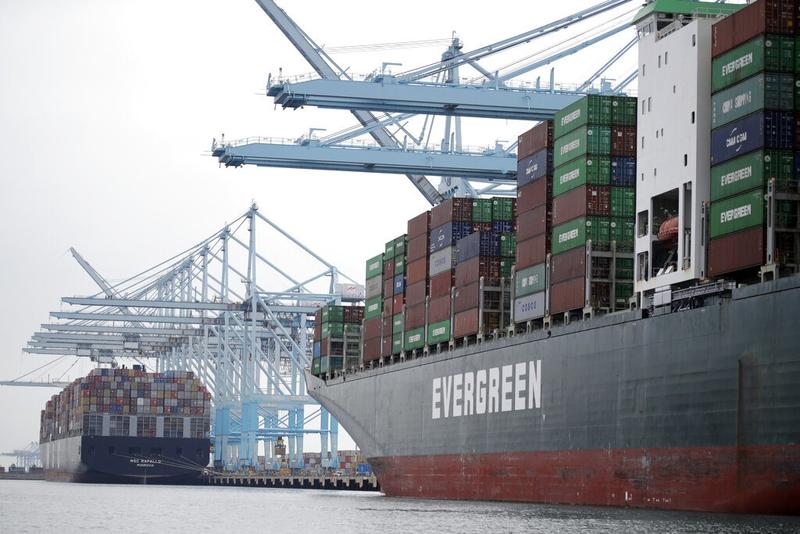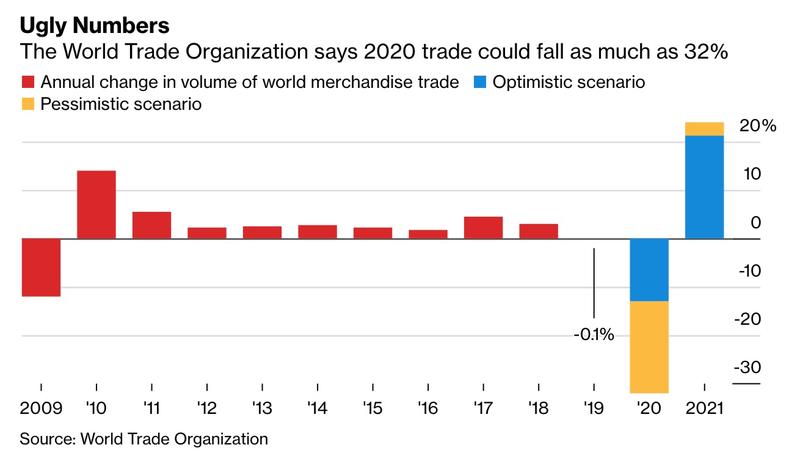 In this June 19, 2019, file photo cargo ships are docked at the Port of Los Angeles in Los Angeles. (PHOTO / AP)
In this June 19, 2019, file photo cargo ships are docked at the Port of Los Angeles in Los Angeles. (PHOTO / AP)
The coronavirus pandemic could cause a deeper collapse of international trade flows than at any point in the postwar era, the World Trade Organization said.
The Geneva-based trade body presented two possible scenarios for global trade in the years to come in a report published Wednesday, noting that the unprecedented nature of the health crisis could result in a wide range of outcomes.
In an optimistic scenario, the WTO said global merchandise trade could fall 13 percent in 2020 and rebound 21 percent in 2021 -- compared with a 0.1 percent contraction in 2019
In an optimistic scenario, the WTO said global merchandise trade could fall 13 percent in 2020 and rebound 21 percent in 2021 -- compared with a 0.1 percent contraction in 2019. In the optimistic scenario, gross domestic product could contract by 2.5 percent in 2020 and grow by 7.4 percent in 2021.
In a pessimistic case, the volume of global goods trade could drop by as much as 32 percent this year with the possibility of a 24 percent increase next year. In this situation, world GDP could shrink by as much as 8.8 percent in 2020 and expand by 5.9 percent in 2021.
If the optimistic scenario is achieved, the WTO projection will rival the modern peacetime record, which was set in 2009, when world merchandise trade volume declined about 12 percent and global GDP contracted 2 percent. If the pessimistic scenario comes to fruition, it could be the most precipitous drop in global commerce since the Great Depression.

“These numbers are ugly -- there is no getting around that,” said WTO Director-General Roberto Azevedo in a statement. “But a rapid, vigorous rebound is possible. Decisions taken now will determine the future shape of the recovery and global growth prospects.”
The forecasts underscore the fact that the world is witnessing a unique health and economic crisis, the likes of which have not been seen in at least a generation. Worldwide, more than 80,000 people have died from COVID-19 and the number of global infections will soon top 1.5 million.
The health crisis has forced the world’s largest economies to tell their citizens to stay home and shutter retail establishments, factories and other non-essential services in order to help suppress the spread of the disease. The life-saving measures have provoked a simultaneous supply and demand shock that’s snarled global production and logistics networks and pummeled consumption of retail goods, travel and hospitality services.
‘Way Worse’
Last week International Monetary Fund Managing Director Kristalina Georgieva said the global economy is already in a recession that is “way worse than the global financial crisis.”
ALSO READ: UN: Global economy could shrink by 1% in '20 due to virus
The depth and duration of the economic downturn largely depends on how long governments maintain their lockdowns -- many of which are expected to last into May or June.
The Paris-based Organization for Economic Cooperation and Development estimates that for each month of containment, there will be a loss of 2 percentage points in annual GDP growth.
Trade in services, which is not factored into the WTO’s merchandise trade forecast, may be the component of world trade most directly affected by Covid-19 and the transport and travel limits it’s causing, the report said. Some declines in services trade during the pandemic may be lost forever.
Regional Effects
”Nearly all regions will suffer double-digit declines in trade volumes in 2020, with exports from North America and Asia hit hardest,” the WTO said.
Trade will fall more steeply in industries characterized by complex value-chain linkages, such as electronics and automotive products, according to the report.
A strong rebound is more likely if businesses and consumers view the pandemic as a temporary, one-time shock, the WTO said.
READ MORE: Closer global cooperation, not trade restrictions, essential
“In this case, spending on investment goods and consumer durables could resume at close to previous levels once the crisis abates,” it said. “On the other hand, if the outbreak is prolonged and/or recurring uncertainty becomes pervasive, households and business are likely to spend more cautiously.”


